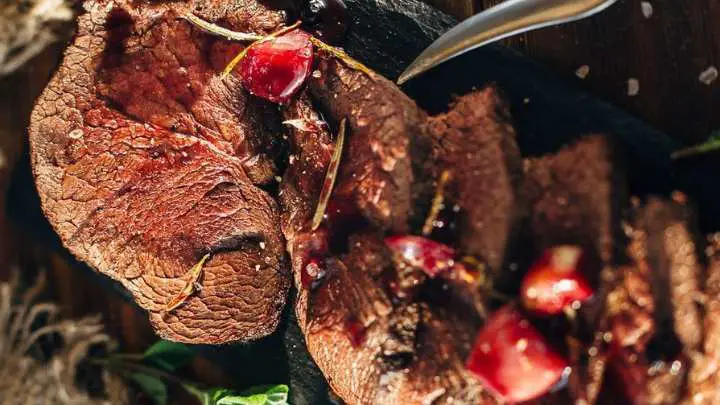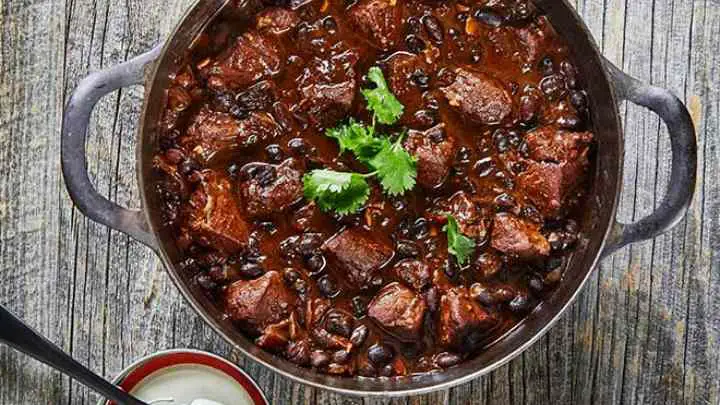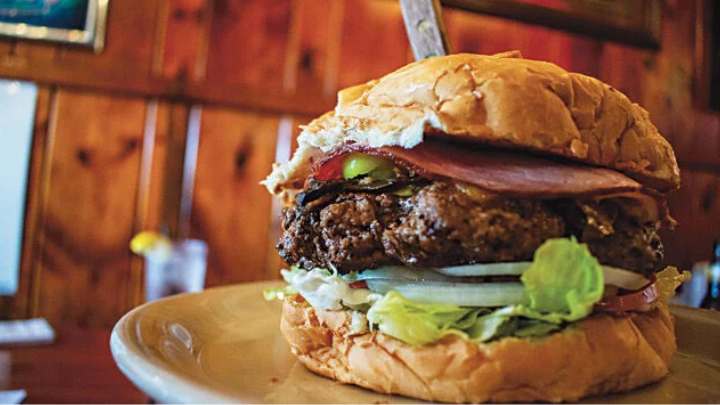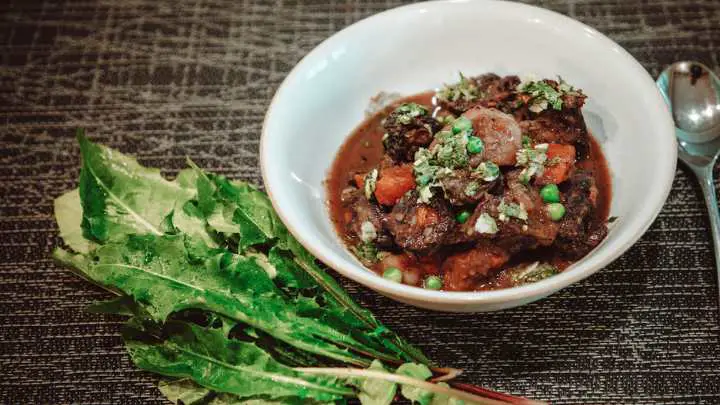Many people are curious about trying unconventional meat like bear meat because they offer unique taste, flavor, and experiences.
Throughout history, bear meat has played a role in various cuisines around the world. From indigenous communities to modern-day chefs, bear meat has been cherished for its rich taste and cultural significance.
What does bear meat taste like? Some say it tastes like a cross between beef and venison. Others say it has a sweet and nutty flavor, especially if the bear ate a lot of berries and nuts.
In this article, you will find out what influences the taste of bear meat, its nutritional value, cooking tips, and popular recipes you can create with it.
Ready to discover the flavors and possibilities of bear meat? Dive in.
What bear meat is

Bear meat holds a significant place in the culinary traditions of many cultures, where it symbolizes strength, resilience, and a deep connection to nature.
Across different indigenous communities, bear meat has been a staple food for centuries, often featured prominently in ceremonial gatherings, rituals, and feasts.
However, the consumption of bear meat is subject to stringent regulations and guidelines aimed at conservation and sustainability. These regulations vary depending on the region and are designed to ensure the protection of bear populations and their habitats.
When considering the consumption of bear meat, it’s essential to understand the characteristics of different bear species.
Black bears, for example, are known for their tender and mild-flavored meat, making them more popular among hunters and consumers.
On the other hand, grizzly and polar bears tend to have tougher and gamier meat, making them less commonly consumed.
What does bear meat taste like?
Bear meat boasts a flavor profile that is rich, gamey, and distinctly wild. Its taste is influenced by the type of bear, the cut, and the bear’s diet, which is typically what is found in its natural habitat.
This unique diet lends bear meat a complex and earthy flavor, with hints of sweetness and nuttiness.
Generally speaking, bear meat is similar to beef or pork, but with a stronger and gamier flavor. Some people say it tastes like a cross between venison and beef. The meat can also be tough and chewy, so it is best to marinate it and cook it slowly.
In terms of texture, bear meat can vary depending on factors such as the age of the bear and the specific cut of meat. When cooked properly, bear meat can be surprisingly tender and juicy, with a satisfying chewiness that adds to its appeal.
Compared to more common meats like beef, pork, and chicken, bear meat offers a distinct culinary experience. It is leaner than beef, with a darker color and a more robust flavor profile.
While pork is often prized for its tenderness and mild taste, bear meat provides a more adventurous alternative. It has a bold flavor and hearty texture that makes it stand out in a variety of dishes.
Similarly, chicken, known for its mild flavor and versatility, pales in comparison to the boldness of bear meat. This is what makes it a preferred choice for those seeking a more adventurous dining experience.
Factors that influence the taste of bear meat
Diet
Bears are omnivores and their diet consists of a wide range of foods including berries, nuts, roots, insects, and occasionally small mammals or fish. The types of foods consumed by a bear can greatly impact the flavor of its meat.
For example, bears that primarily feed on berries may have sweeter and more fruity-flavored meat, while those that consume more protein-rich foods like fish may have a stronger, more savory taste.
Habitat
The environment in which a bear lives can also affect the taste of its meat.
Bears that inhabit coastal regions and feed on a diet rich in fish may have meat with a more pronounced seafood flavor, whereas bears living in forested areas may have meat with earthy undertones from foraging on nuts and roots.
Age
The age of the bear at the time of harvest can influence the tenderness and flavor of its meat. Younger bears typically have more tender meat with a milder flavor, while older bears may have tougher meat with a stronger, gamier taste.
Season
The season in which a bear is harvested can also impact the taste of its meat. Bears that are harvested in the fall after fattening up for winter hibernation may have meat that is richer and more flavorful compared to bears harvested in the spring or summer.
Health benefits and concerns of eating bear meat
Bear meat offers a range of health benefits, yet it also presents potential health risks that consumers should consider.
Nutritional value
Rich in protein, bear meat promotes muscle growth and repair.
It also contains essential vitamins like B vitamins, supporting metabolism and energy production, along with minerals such as iron and zinc, crucial for immune function and overall well-being.
Benefits
With its lean protein content, bear meat aids in maintaining muscle mass and promoting satiety, making it a valuable addition to a balanced diet. Additionally, the vitamins and minerals found in bear meat contribute to optimal health and vitality.
Health risks
Bear meat may harbor parasites and pathogens, particularly if mishandled or undercooked. These contaminants can lead to foodborne illnesses and infections, posing risks to consumers’ health.
To minimize health risks while enjoying the nutritional benefits of bear meat, it’s essential to follow proper handling, cooking, and consumption practices. Thorough cooking kills harmful bacteria and parasites, ensuring a safe and enjoyable dining experience.
Additionally, sourcing bear meat from reputable suppliers and adhering to relevant food safety guidelines further reduces the likelihood of foodborne illnesses.
Cooking with bear meat
Cooking with bear meat opens up a world of culinary possibilities, but it requires careful attention to enhance its flavor and tenderness while ensuring safe preparation and consumption.
Preparing the meat
Marinating bear meat before cooking can significantly enhance its flavor and tenderness.
Opt for acidic marinades containing ingredients like vinegar, citrus juice, or wine, as the acidity helps break down tough muscle fibers and infuses the meat with delicious flavors.
Marinating for several hours or even overnight allows the flavors to penetrate deeply into the meat, resulting in a more flavorful and tender dish.
Slow cooking
Slow cooking methods such as braising, stewing, or slow roasting are ideal for bear meat.
These methods involve cooking the meat at low temperatures for an extended period, allowing the collagen and connective tissues to break down slowly, resulting in tender, melt-in-your-mouth meat.
Use bold seasonings
Bear meat’s robust flavor can stand up to bold seasonings and herbs. Experiment with garlic, rosemary, thyme, sage, and other aromatic spices to enhance the natural flavors of the meat.
Consider creating a flavorful dry rub or marinade using a combination of herbs, spices, and aromatics to add depth and complexity to your bear meat dishes.
Pairings
When it comes to pairing bear meat with complementary ingredients, consider balancing its richness with contrasting flavors and textures. Tangy sauces, such as barbecue or fruit-based glazes, can add a bright, acidic contrast to the meat’s richness.
Sweet fruits like berries or figs can provide a subtle sweetness, while earthy vegetables like mushrooms or root vegetables can complement the meat’s savory flavors.
Safe preparation
It’s essential to ensure that bear meat is cooked thoroughly to kill any potential parasites or bacteria.
Use a meat thermometer to ensure that the internal temperature of the meat reaches at least 160°F (71°C) to ensure its safety. Avoid consuming bear meat that is undercooked or rare, as this increases the risk of foodborne illness.
Avoid overcooking
While it’s crucial to cook bear meat thoroughly, overcooking can result in tough, dry meat. Aim for a medium-rare to medium doneness to preserve the meat’s juiciness and tenderness.
Keep a close eye on the cooking time and use a meat thermometer to prevent overcooking, allowing you to enjoy the full flavor and texture of the meat.
Best bear meat recipes
Here are a few recipes to inspire your next bear meat cooking adventure:
Bear chili

This hearty and comforting dish combines tender bear meat with beans, tomatoes, and aromatic spices for a flavorful chili that’s perfect for chilly nights.
Brown the meat with onions and garlic before simmering it with tomatoes, beans, chili powder, cumin, and paprika until thick and flavorful.
Bear burger

Elevate your burger game with juicy bear meat patties seasoned with salt, pepper, and your favorite herbs and spices.
Grill or pan-sear the patties to perfection and serve on a toasted bun with your choice of toppings and condiments for a delicious and satisfying meal.
Bear stew

Warm up with a hearty bear stew, featuring tender chunks of bear meat simmered with vegetables and herbs in a rich and savory broth.
Brown the bear meat in a pot before adding onions, carrots, potatoes, and herbs like thyme and bay leaves. Simmer until the meat is tender and the flavors meld together beautifully.
Bear roast

Impress your guests with a flavorful bear roast, seasoned with garlic, rosemary, and other aromatic herbs.
Slow roast the bear meat in the oven until it’s tender and juicy, then serve with roasted vegetables and a savory pan gravy for a delicious and elegant meal.
Bear tacos

Create flavorful bear tacos by seasoning diced bear meat with a blend of chili powder, cumin, garlic, and paprika.
Sauté the seasoned meat with onions and peppers until cooked through, then serve on warm tortillas with your favorite toppings such as salsa, guacamole, and shredded cheese for a delicious and satisfying meal.
FAQs
How does bear meat compare to other meats?
Bear meat offers a rich, gamey flavor that sets it apart from more common meats like beef, pork, and chicken.
Its taste can be described as earthy with hints of sweetness and nuttiness, reflecting the bear’s natural diet. Additionally, bear meat tends to have a leaner texture compared to beef or pork.
What factors affect the taste of bear meat?
Several factors influence the taste of bear meat, including the bear’s diet, habitat, age, exercise levels, and genetics.
Bears that consume a varied diet of berries, nuts, and vegetation may have sweeter and more flavorful meat, while older bears may have tougher and more pronounced flavors.
Are there different tastes between bear species?
Yes, there can be differences in taste between bear species. For example, black bear meat is known for its mild flavor and tenderness, while grizzly or polar bear meat may be tougher and have a stronger, gamier taste.
Is cooking bear meat different from other meats?
Cooking bear meat requires some special considerations due to its unique flavor and texture. Marinating the meat before cooking can help tenderize it and enhance its flavor.
Additionally, bear meat benefits from slow cooking methods like braising or stewing to ensure optimal tenderness.
Conclusion
Bear meat brings a special taste and can be cooked in many ways. Whether enjoyed in comforting stews, hearty roasts, or flavorful tacos, bear meat adds an adventurous twist to any meal.
Trying unconventional meats like bear meat provides an opportunity to expand your culinary horizons and embrace new flavors.
However, it’s essential to approach these culinary adventures responsibly, ensuring safe handling, cooking, and consumption practices.
So, dare to explore the world of bear meat and other unconventional ingredients, but do so with caution and respect for the environment and wildlife.
Penguin meat is another unconventional meat to treat your taste buds to. Learn about its flavor profile, health benefits, and ethical considerations.
Thanks for reading.

